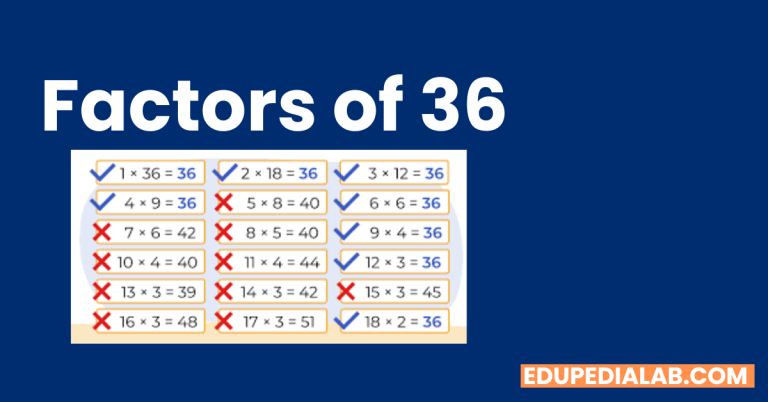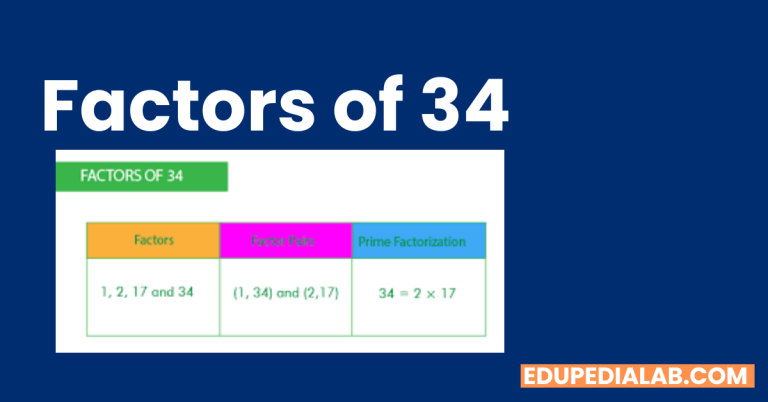Factors Of 13 (Explained By Experts)
Factors Of 13
Numbers have fascinated humans for centuries. From the simplicity of counting to the complexity of mathematical equations, numbers hold a special place in our lives. One such number that has intrigued mathematicians and enthusiasts alike is 13. In this comprehensive article, we will delve into the fascinating world of the Factors of 13. We will explore its significance, properties, and the various aspects that make it a truly unique number. So, fasten your seatbelts and get ready for an exhilarating journey through the world of mathematics!
The number 13 is among one the Factors Of 26.

Factors Of 13
Let’s start our exploration by understanding the Factors of 13. Factors are the numbers that divide a given number without leaving a remainder. For example, the factors of 6 are 1, 2, 3, and 6. Similarly, the factors of 13 are 1 and 13. Since 13 is a prime number, it only has two factors – 1 and the number itself.
Prime Numbers: The Building Blocks of Mathematics
Before we dive deeper into the factors of 13, it is essential to understand the concept of prime numbers. Prime numbers are the building blocks of mathematics. They are the numbers greater than 1 that cannot be divided evenly by any other number except 1 and itself. For example, 2, 3, 5, 7, 11, and 13 are all prime numbers. They are the foundation upon which various mathematical concepts and theories are built.
The Significance of 13
The number 13 has always held a special place in human history, but not always for positive reasons. In many cultures, it is considered an unlucky number, leading to superstitions and fear. However, it is important to remember that these beliefs are subjective and vary from culture to culture. In fact, 13 has also been associated with luck in some traditions, such as the concept of the “lucky 13” in Italian culture.
Properties of 13
Let’s take a closer look at the properties of the number 13:
- Odd Number: 13 is an odd number, which means it is not divisible by 2.
- Prime Number: As mentioned earlier, 13 is a prime number, as it has only two factors – 1 and 13.
- Palindromic Prime: 13 is a palindromic prime, meaning it remains the same when its digits are reversed.
- Fibonacci Number: 13 is also a member of the Fibonacci sequence, a series of numbers where each number is the sum of the two preceding ones. In this sequence, 13 comes after 8 and before 21.
- Binary Representation: In binary representation, 13 is represented as 1101.
- Hexadecimal Representation: In hexadecimal representation, 13 is represented as D.
- Numerology: In numerology, 13 is considered a karmic number, often associated with transformation and rebirth.
FAQs about Factors of 13
Q1: Is 13 a prime number?
Yes, 13 is a prime number as it has only two factors – 1 and 13.
Q2: Are there any other factors of 13?
No, since 13 is a prime number, it does not have any other factors apart from 1 and 13.
Q3: What is the significance of 13 in various cultures and traditions?
The significance of 13 varies across different cultures and traditions. In some Western cultures, the number 13 is associated with bad luck and superstitions. For example, Friday the 13th is considered an unlucky day. However, in other cultures, such as Chinese and Italian, 13 is regarded as a lucky number. In Chinese culture, 13 is associated with good fortune and prosperity.
Q4: Is there any mathematical significance to the number 13?
Mathematically, the number 13 holds its own significance. As a prime number, it plays a vital role in number theory and mathematical calculations. Its unique properties and characteristics make it an intriguing subject of study for mathematicians and researchers.
Q5: Are there any real-life applications of the number 13?
While the number 13 might not have direct practical applications in everyday life, its presence and properties have influenced various fields. For instance, in architecture and design, some buildings intentionally skip the 13th floor due to the superstition surrounding the number. Similarly, in mathematics, the number 13 is utilized in equations, formulas, and mathematical proofs.
Q6: Are there any interesting facts about the number 13?
Certainly! Here are a few interesting facts about the number 13:
- The famous painter and mathematician, Leonardo da Vinci, believed that the number 13 held mystical powers and incorporated it into many of his works.
- The United States of America has a 13-step pyramid on the back of the one-dollar bill, symbolizing the original 13 colonies.
- There are 13 stripes on the American flag, representing the same 13 colonies.
- Apollo 13, the seventh manned mission in NASA’s Apollo space program, famously encountered an oxygen tank explosion but managed to safely return to Earth.
- Many hotels and buildings skip the 13th floor, jumping directly from 12 to 14, due to the superstition associated with the number.
Conclusion
In conclusion, the Factors of 13 open a gateway to exploring the intricacies of number theory and mathematics. As a prime number with unique properties, 13 holds a significant place in our history, culture, and scientific pursuits. Whether considered unlucky or lucky, the number 13 has captivated the human imagination and continues to intrigue mathematicians, researchers, and enthusiasts worldwide. So, the next time you encounter the number 13, embrace its fascinating nature and appreciate the mathematical wonders it represents.





